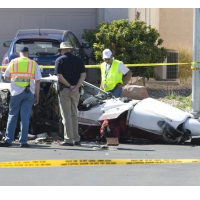FAA Allowed Small Plane Manufacturers to Save Money on Possible Post-Impact Fires…and at least 600 People Died
 Small plane crash and fire in Henderson, Nevada (AP Photo)
Small plane crash and fire in Henderson, Nevada (AP Photo)
What’s your life worth? According to the Federal Aviation Administration (FAA), if you fly in a private plane, you’re worth only $1 million.
Post-crash fires in small airplanes have killed at least 600 people since 1993, according to an investigation of small-plane safety by USA Today. Many of the victims had no broken bones or internal injuries, but succumbed to fire or its effects. But when the FAA tried in 1990 to impose new safety standards that would keep small planes from leaking fuel that causes the fires, manufacturers fought back. In response, the FAA determined the $1 million figure, which would mean the costs of making the planes safe would outweigh the benefits. The cost per plane would have been between $556 and $5,710, according to USA Today’s investigation.
Other agencies have different, mostly higher, valuations on human lives. The Environmental Protection Agency values lives at $3.3 million and the Department of Transportation says a human is worth $9.1 million.
According to an investigation (pdf) into post-impact fires (PIFs) using Transportation Safety Board of Canada data, “Volatile liquid fuel is the combustible material of greatest significance in PIF accidents. Considering the propensity for rapid propagation and the catastrophic consequences of fuel-fed PIF, the most effective defense against PIF is to prevent the fire from occurring at impact, either by containing fuel or preventing ignition, or both.”
But while passenger cars are required to leak 1 ounce of fuel or less per minute after a 50 mile-per-hour rear-end crash, private planes certified by the FAA are required merely to “retain fuel,” and then only after landings with collapsed or retracted landing gear. “The FAA standards are horribly inadequate,” Harry Robertson, who has consulted for the FAA on fire prevention and in the 1960s designed crash-resistant fuel systems for the Army, told USA Today.
The National Transportation Safety Board has made safety recommendations, including one in 1980 to research rupture-resistant fuel tanks, but has been rebuffed by the FAA. Other criticisms have come from outside the country. The Transportation Safety Board of Canada wrote last year, “The FAA appears not to recognize the risks associated with post-impact fires or the potential to mitigate those risks.”
Meanwhile, people in the United States continue to die of fires in small-plane crashes. At least 26 people have died, at least in part because of post-impact fires, in the past five months.
-Steve Straehley
To Learn More:
Post-Crash Fires in Small Planes Cost 600 Lives (by Thomas Frank, USA Today)
Aviation Safety Issues Investigation Report SII A05-01 (pdf)
- Top Stories
- Unusual News
- Where is the Money Going?
- Controversies
- U.S. and the World
- Appointments and Resignations
- Latest News
- Trump to Stop Deportations If…
- Trump Denounces World Series
- What If China Invaded the United States?
- Donald Trump Has a Mental Health Problem and It Has a Name
- Trump Goes on Renaming Frenzy






Comments